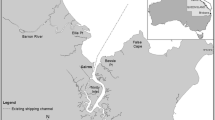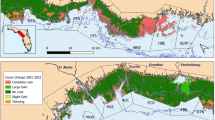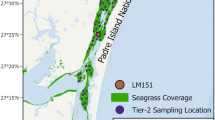Abstract
Seagrass both disappeared and recovered within 4 yr in one region of northern Indian River Lagoon (IRL). For the specific area referred to as Turnbull Bay, a relatively pristine area of the IRL, over 100 ha of seagrass completely disappeared from 1996 to 1997 and then recovered by 2000. Based on lagoon-wide mapping from aerial photographs taken every 2–3 years since 1986, coverage of seagrass in Turnbull Bay declined from 124 ha in 1989 to 34 ha by 1999 and increased to 58 ha in 2003. Bi-annual monitoring of fixed seagrass transects tells a more detailed story. Species composition along the Turnbull transect shifted fromHalodule wrightii toRuppia maritima beginning in 1995, and macroalgal abundance increased. By the summer of 1997, seagrass completely disappeared along the transect, as well as in most of the surrounding areas in Turnbull Bay; macroalgae covered much of the sediment surface. No significant water quality changes were detected. Light attenuation and suspended solid values did increase after the seagrass disappeared. Porewater sulfide concentrations, taken after all the grass was gone in 1997, were high (2,000 μM), but did improve by 1998 (1,200 μM). Seagrass recovery was rapid and occurred in the reverse sequence of species loss. Seedlings ofR. maritima were the first colonizers, then patches ofH. wrightii appeared. In 2000,Halophila engelmannii returned in the deeper water (>0.6m). By the summer of 2000, the beds had completely recovered. We conclude that this demise was a natural event caused by a long-term buildup of seagrass biomass and a thick (10–15 cm) layer of organic detritus and ooze. We surmise that such a crash and subsequent recovery may be a natural cycle of decline and recovery within this semirestricted, poorly-flushed area. The frequency of this cycle remains uncertain.
Similar content being viewed by others
Literature Cited
Carlson, P. R., L. A. Yarbro, andT. R. Barber. 1994. Relationship of sediment sulfide to mortality ofThalassia testudinum in Florida Bay.Bulletin of Marine Science 54:733–746.
Carlson, P. R., L. A. Yarbro, C. F. Zimmermann, andJ. R. Montgomery. 1983. Pore water chemistry of an overwash mangrove island.Florida Scientist 46:239–249.
Goodman, J. L., K. A. Moore, andW. C. Dennison. 1995. Photosynthetic responses of eelgrass (Zostera marina L.) to light and sediment sulfide in a shallow barrier island lagoon.Aquatic Botany 50:37–47.
Hall, L. M. 2002. Fragments of the seagrassesHalodule wrightii andHalophila johnsonii as potential recruits in the Indian River Lagoon, Florida. M.S. Thesis, Florida Institute of Technology, Melbourne, Florida.
Kemp, W. M., R. R. Twilley, J. C. Stevenson, W. R. Boynton, andJ. C. Means. 1983. The decline of submerged vascular plants in upper Chesapeake Bay: Summary of results concerning possible causes.Marine Technology Society Journal 17:78–85.
Martin, J. B., J. E. Cable, and P. W. Swarzenski. 2002, Quantification of groundwater discharge and nutrient loading to the Indian River Lagoon—Final report. St. Johns River Water Management District. Special Publication #SJ2002-SP5. Palatka, Florida.
Morris, L. J., L. M. Hall, andR. W. Virnstein. 2001. Field guide for fixed seagrass transect monitoring in the Indian River Lagoon, 1st edition. St. Johns River Water Management District, Palatka, Florida.
Onuf, C. P. 2000. Seagrass responses to and recovery from seven years of brown tide.Pacific Conservation. Biology 5:306–313.
Pulich, M. B. 1983. Growth responses ofHalophila engelmannii Ascherson to sulfide, copper, and organic nitrogen in marine sediments.Plant Physiology 71:975–978.
Robblee, M. B., T. R. Barber, P. R. Carlson, M. J. Durako, J. W. Fourqurean, L. K. Muehlstein, D. Porter, L. A. Yarbro, R. T. Zieman, andJ. C. Zieman. 1991. Mass mortality of the tropical seagrassThalassia testudinum in Florida Bay (USA).Marine Ecology Progress Series 71:297–299.
Sigua, G. C., J. S. Steward, and W. A. Tweedale. 1999. Status of water quality in the Indian River Lagoon system: Spatial and temporal trends—Summary report (1988–1994). St. Johns River Water Management District. Technical Memorandum No. 33. Palatka, Florida.
Steward, J. S., R. Brockmeyer, R. W. Virnstein, P. Gostel, P. Sime, andJ. VanArman. 2003. Indian River Lagoon Surface Water Improvement and Management Plan, 2002 Update. St. Johns River Water Management District, Palatka, Florida and South Florida Water Management District, West Palm Beach, Florida.
Virnstein, R. W. 2000. Seagrass management in Indian River Lagoon, Florida: Dealing with issues of scale.Pacific Conservation Biology 5:299–305.
Virnstein, R. W. and L. J. Morris. 1996. Seagrass preservation and restoration: A diagnostic plan for the Indian River Lagoon. St. Johns River Water Management District. Technical Memorandum No. 14. Palatka, Florida.
Zimmermann, C. F. andJ. R. Montgomery. 1984. Effects of a decomposing drift algal mat on sediment pore water nutrient concentrations in a Florida seagrass bed.Marine Ecology Progress Series 19:299–302.
Author information
Authors and Affiliations
Corresponding author
Rights and permissions
About this article
Cite this article
Morris, L.J., Virnstein, R.W. The demise and recovery of seagrass in the northern Indian River Lagoon, Florida. Estuaries 27, 915–922 (2004). https://doi.org/10.1007/BF02803418
Received:
Revised:
Accepted:
Issue Date:
DOI: https://doi.org/10.1007/BF02803418




